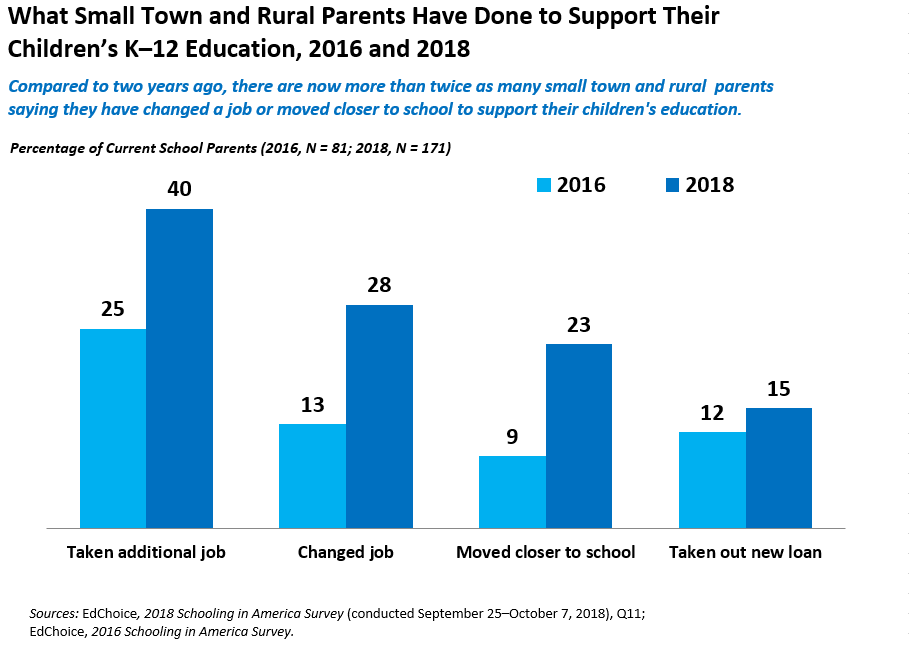Schooling in America Series: Rural Revisited
Since the 2016 election turned the spotlight on small town and rural Americans, the education policy world has been playing catch up to the experiences and needs of these communities.
Authors in the American Enterprise Institute’s No Longer Forgotten: The Triumphs and Struggles of Rural Education in America offer insight into these communities’ educational landscapes. They find:
- Schools in small towns and rural areas tend to outperform their urban counterparts, including on measures like high school graduation rates
- Rural communities display a high degree of cohesiveness, and their schools often tend to be a centerpiece of the social fabric
- As rural communities undergo change and challenges, the goals and purpose of rural education leads to important implications
The book, which was edited by Andy Smarick and Mike McShane, also discuss online education’s place in the rural education landscape. School choice policies like education savings accounts or ESAs can offer hope to rural parents seeking otherwise distant schooling options for their children in the form of online or blended learning. But with 24 percent of rural adults saying access to high-speed internet is a major problem in their community, online learning appears to be just part of the education puzzle for small town and rural families.
Of course, just like the national dialogue, one can paint too broad a brush when discussing small town and rural communities. Demographic compositions such as race and the rate of poverty in small towns and rural areas vary depending on which region of the country is being examined. As Smarick and McShane write, “there is no one satisfying definition of ‘rurality,’ either statistically, geographically, or historically.”
In this series, we’re incorporating other polling and K–12 education pieces to add context to our 2018 Schooling in America Survey. Today, we’re focusing on results from parents and residents who live in small towns and rural communities.
Direction of Education and Accountability Purpose
One in three (34 percent) small town and rural residents think things are going in the right track nationally with K–12 education. More than half (55 percent) say it has gotten off on the wrong track. One in 10 (11 percent) were unsure of their opinion on K–12 education nationally, which was a higher percentage than the general population (9 percent) and urban residents (6 percent).
About half (48 percent) of superintendents in rural areas are excited about the future of their district, according to a This was a lower percentage than urban (65 percent) and suburban (53 percent) superintendents, who have been more excited than rural superintendents about the future of their districts over the years.
According to the latest PDK Poll, about half (48 percent) of rural residents say they have fewer educational opportunities than those living in larger communities. About a third of Americans think schools have lower expectations for rural students than those in other communities.
One in three (33 percent) small town and rural residents in our survey prioritized rewarding high-performing schools as a primary purpose of an education accountability system. This percentage was significantly higher than current public school teachers (26 percent).
The 2018 PDK poll found over half (55 percent) of those in rural areas support spending more money on needier students rather than spending the same amount on all students. For comparison, it found seven in 10 urban residents supporting spending relatively more for needier students. To meet such a goal, rural residents preferred spending less on other students (57 percent) as opposed to raising taxes for such spending (41 percent).
Rural Parents’ Experiences and Sacrifices
Parents in small town and rural communities from our survey were less likely to have their children experience charter , and a relatively low percentage (13 percent) had sent their child to a private school for one or more years. That ratio may be mitigated by the 10 percent of small town and rural parents who have tried homeschooling for at least a year. The vast majority of parents in small towns and rural areas have sent their children to traditional public schools (88 percent) at least one year, which is not significantly different from the general public.
Parents in small towns and rural communities are doing more to support their children’s K–12 education. Four in 10 (40 percent) say they have taken an additional job for reasons related to their child’s education, which is a 15-point increase since 2016. More than twice as many rural parents (28 percent) have changed jobs since 2016.

Interestingly, small town/rural parents were more likely to say they have moved closer to a child’s school (77%) than both urban parents (61%) and all school parents (71%). A related question found parents living in small towns and rural communities were less likely (29 percent) than urban parents (45 percent) to have paid for transporting their child to or from school. These parents also were more likely to say they have not taken out a loan to support their child’s K–12 education (86 percent) than urban (71 percent) and all school parents (79 percent).
Other Posts in the Schooling in America Series
Schooling in America Series: Getting to Know Our Teachers
Schooling in America Series: Getting to Know School Parents
Schooling in America Series: Getting to Know the Public on Public Education
Schooling in America Series: K-12 Education Funding
Schooling in America Series: The Public on School Choice
Schooling in America Series: The Public on K–12 Accountability
Schooling in America Series: Teachers’ Views on Accountability and School Choice
Schooling in America Series: Parents’ Views on Accountability and School Choice




